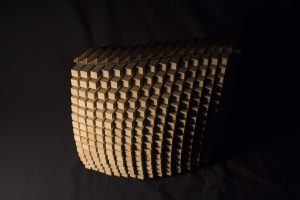By Laurie Elfassy

The original intention for this sculpture was to use the concept of pixels to play with the perception of light, depth and form. Using the same size sticks (12 mm x 12 mm x 100 mm), the parametric form is created by the structure bracing the sticks from the center. This creates a sculpture with no determined direction or orientation – the sculpture is to be rotated in all directions to perceive the many different games of light, depth and form the sculpture takes on. The structure is made up of 3mm thick plywood, which allows for a discrete gap between the sticks, once again to increase the disorienting perception of the sculpture. MDF is used for the sticks due to the fact that it is a material with no grain. A material with grain would have been an added factor to read and therefore a nuisance to the observer. The sculpture is intended to play on what the observer abstractly perceives (in terms of light, depth and form) rather then on what is physically there. It is interesting to note that when working with digitally designed forms, the output in real life is not always what we expect. As seen in the drawings above, the sculpture was originally designed on the computer with the sticks standing verticallystraight. However, in reality, the sculpture rests in positions that orientate the sticks diagonally, giving much more depth to the sculpture.

